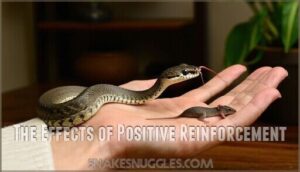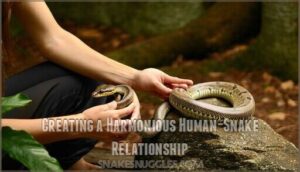This site is supported by our readers. We may earn a commission, at no cost to you, if you purchase through links.

However, your snake can learn to recognize you through scent and associate your presence with positive experiences like feeding.
This process, called classical conditioning, creates comfort rather than affection.
Your snake’s calm behavior around you isn’t love—it’s learned recognition that you’re safe and bring good things.
While they can’t feel friendship, snakes do respond to consistent, gentle handling by becoming less stressed.
Think of it as mutual respect rather than companionship.
Understanding this reality actually strengthens your relationship by setting appropriate expectations for what’s truly possible, based on complete concepts and separate lines of thought, leading to a deeper understanding of emotional attachment and gentle handling.
Table Of Contents
- Key Takeaways
- Can Snakes Form Emotional Bonds
- Snakes as Pets: a Suitable Relationship
- The Science Behind Snake Behavior
- Do Snakes Benefit From Human Interaction
- The Ethics of Keeping Snakes as Pets
- Snakes in The Natural World
- Debunking Common Snake Myths
- Snakes and Human Health
- Creating a Harmonious Human-Snake Relationship
- Frequently Asked Questions (FAQs)
- How are snake-human bonds different from bonds with other pets?
- Can snakes bond with humans?
- How do snakes recognize their human owners?
- Do snakes have a relationship with humans?
- Can snakes form bonds with their owners?
- Are pythons good snakes to bond with?
- Is it possible for snakes to bond with humans?
- Do snakes value human companionship?
- Is it possible for snakes to have feelings?
- Can snakes get attached to humans?
- Conclusion
Key Takeaways
- You can’t form emotional bonds with snakes – They lack the brain structures needed for emotional attachment, so what feels like bonding is actually classical conditioning and scent recognition.
- Your snake recognizes you through smell, not affection – They use their forked tongue and Jacobson’s organ to identify your scent and associate you with positive experiences like feeding and safety.
- Consistent handling creates comfort, not friendship – Regular, gentle interaction reduces your snake’s stress and builds familiarity, but this represents learned behavior rather than genuine companionship.
- You’ll have a successful relationship by managing expectations – Understanding that snakes respond through conditioning rather than emotion helps you create realistic care routines based on mutual respect.
Can Snakes Form Emotional Bonds
You might wonder if your pet snake actually cares about you or just sees you as a walking food dispenser.
The truth lies in understanding how snake brains work – they can’t form emotional bonds like mammals do, but they can develop positive associations with their owners through conditioning and familiarity.
Snakes recognize you through scent and conditioning, not love—but that doesn’t make the bond any less meaningful
Snakes’ Limited Cognitive Abilities
Snakes typically operate with brain structure that limits complex thinking.
Their reptilian brains rely on basic neural functions rather than emotional processing.
Here’s what shapes their cognitive limits:
- Sensory perception drives most behaviors through smell and taste detection
- Learning mechanisms focus on survival patterns like feeding and threat responses
- Snake cognition centers on instinctual reactions rather than conscious thought
- Species differences affect how individual snakes process environmental information
Classical Conditioning and Association
Why does your snake seem to recognize you? Through classical conditioning, your pet learns to link your scent and presence with feeding time.
This associative learning creates predictable responses—your snake approaches because you mean food, not friendship.
| Conditioning Element | Snake’s Response |
|---|---|
| Your scent | Increased activity |
| Feeding schedule | Anticipatory behavior |
| Gentle handling | Reduced stress |
| Consistent routine | Habit formation |
| Positive stimuli | Approach behavior |
This stimulus response pattern strengthens over time, making human snake interaction appear bonded when it’s really learned behavior through operant conditioning.
The Role of Smell and Taste in Recognition
Your pet snake recognizes you through chemical sensing rather than sight.
Your snake knows you by scent, not sight—their forked tongue is like a chemical ID scanner
Their forked tongue collects chemical signals from the air, transferring information to the vomeronasal organ for processing.
Key aspects of snake sensory perception:
- Smell recognition – Snakes identify familiar scents through repeated exposure
- Taste cues – The Jacobson’s organ processes chemical information like a sophisticated taste system
- Olfactory system – This sensory network creates associations between your scent and positive experiences
Snakes’ Response to Positive Stimuli
Classical Conditioning explains your snake’s response to positive stimuli. When you consistently pair feeding with handling, your snake develops stimulus response patterns through positive reinforcement.
This creates snake recognition of beneficial interactions, but it’s learned behavior, not emotional bonding.
| Stimulus Type | Snake Response |
|---|---|
| Food presentation | Approach behavior |
| Gentle handling | Reduced stress hormones |
| Warm environment | Increased activity |
Environmental enrichment strengthens these conditioned responses, improving your snake human bond through predictable positive interaction patterns.
Snakes as Pets: a Suitable Relationship
When you’re considering a snake as a pet, your expectations will shape the entire relationship experience.
Understanding what snakes can and can’t provide emotionally helps you create the right environment for both you and your scaly companion.
The Importance of Owner Expectations
Unfortunately, many prospective owners harbor unrealistic expectations about snake bonding.
Research shows only 13% accurately understand snakes’ behavioral limitations before adoption.
This Owner Awareness gap leads to disappointment when Pet Realism doesn’t match fantasy.
Your Human Perception of snake bonding must align with science—snakes respond through conditioning, not affection.
Proper Bonding Strategies focus on consistent care rather than emotional reciprocity for successful snake human interaction.
Understanding snake sensory capabilities is essential for developing effective care and interaction techniques.
Providing a Suitable Environment
Your snake’s enclosure design matters more than you might think.
Create a spacious snake habitat that’s twice your snake’s length and equally wide. Install proper temperature control systems with heating elements and thermostats.
Add hiding places, suitable substrate, and water sources for complete environmental enrichment. These space requirements guarantee your snake’s comfort and reduce stress naturally.
A well-planned snake enclosure is vital for maintaining your pet’s overall health.
Regular Feeding and Care
Establishing a consistent feeding schedule creates predictability for your snake and simplifies care routines.
Research your species’ dietary requirements—most adult snakes eat every 7-14 days. Proper snake care involves understanding the right feeding products.
Maintain proper enclosure size with adequate habitat maintenance, including spot-cleaning waste and monitoring water quality weekly.
During shedding periods, increase humidity and provide rough surfaces for shedding assistance.
These fundamentals support snake comfort and successful human-snake interaction, laying groundwork for snake bonding.
The Impact of Owner Interaction on Snakes
When you interact with your snake regularly, you create stress reduction through familiar scents and gentle movements.
Handling frequency affects temperament changes – well-socialized snakes show calmer snake behavior signals.
Your voice and touch provide enrichment effects, making humansnake interaction more positive.
Snake comfort increases with consistent snake handling, though this represents conditioning rather than emotional snake bonding.
The Science Behind Snake Behavior
Understanding snake behavior requires examining their neurological wiring and sensory capabilities.
You’ll discover that snakes operate through basic survival instincts rather than complex emotional processing, relying heavily on chemical detection and environmental cues to navigate their world, utilizing chemical detection to a great extent.
Basic Instincts and Survival Needs
Your snake’s behavior runs on autopilot—driven by hardwired snake instincts focused on survival.
These basic drives shape everything from their solitary nature to their mysterious responses to your handling attempts.
- Hunting Strategies – They’re wired to detect prey through heat and movement
- Predator Avoidance – Hiding and defensive posturing keep them alive
- Thermoregulation – Temperature control drives their daily activity patterns
- Mating Rituals – Seasonal breeding behaviors override normal routines
The Role of Smell and Taste in Navigation
Building on basic survival instincts, snakes navigate primarily through chemoreception mechanisms. Their forked tongue flicking collects scent particles, transferring them to the Jacobson’s organ for chemical analysis.
This snake olfactory sense creates detailed scent maps for prey detection and processing environmental cues. Snakes use their taste buds, located on the mouth’s roof, to perform chemical signal analysis.
| Navigation Method | Primary Function | Effectiveness | Limitations | Examples |
|---|---|---|---|---|
| Chemoreception | Chemical detection via tongue | Highly accurate | Weather dependent | Following prey trails |
| Snake vision | Movement detection | Limited range | Poor in darkness | Spotting predators |
| Snake touch | Vibration sensing | Ground-level only | Short distance | Detecting footsteps |
| Snake taste | Chemical identification | Species-specific | Requires direct contact | Identifying food sources |
| Heat detection | Thermal sensing | Precise targeting | Close range only | Locating warm prey |
This sophisticated snake taste and smell system compensates for their limited visual and auditory abilities, making chemical navigation their primary survival tool.
Limited Memory and Recognition
Anyone can spot that snakes aren’t memory champions.
Your pet snake recognizes you through scent recognition and visual familiarity, but recall limitations mean they won’t remember yesterday’s interaction.
Snake cognition studies show reptilian cognition relies on learned associations and habituation rather than complex memory.
Snake recognition develops through repeated exposure, making snake familiarity a gradual process.
Responding to Environmental Stimuli
Environmental factors drive every aspect of snake behavior through sensory perception and learned responses.
Temperature influence affects their activity levels, while specialized organs help with prey detection and habitat selection.
Here’s how environmental stimuli shape their world:
- Heat-sensing pits detect warm-blooded prey from several feet away
- Chemical cues guide snake responses to food sources and potential mates
- Vibrations through their jaw bones alert them to approaching threats
These snake signals create predictable patterns in snake temperament, though they don’t indicate emotional snake bonding with humans.
Do Snakes Benefit From Human Interaction
While you can’t force an emotional connection with your snake, regular interaction does provide measurable benefits for their wellbeing.
You’ll create a calmer, more predictable environment that reduces stress and allows your snake to thrive in captivity.
The Impact of Handling on Snakes
Your touch matters more than you might think.
Handling stress builds when you grip too tightly or move suddenly, triggering defensive responses.
Gentle, consistent snake handling reduces anxiety and promotes habituation effects.
Handling frequency shapes temperament changes – regular, calm sessions help snakes adapt to human contact.
Poor technique increases injury risks for both parties.
Understanding snake stress signals helps you adjust your approach, fostering healthier human-snake relationships.
Providing Enrichment and Stimulation
Your snake’s enrichment needs go beyond basic care. Enrichment Types like climbing branches, hiding spots, and Novel Objects trigger natural investigation behaviors.
Studies show snakes with varied Habitat Design display increased activity and exploration. Rotate items weekly to maintain Behavioral Variety.
Sensory Input from new scents or textures stimulates their chemosensory system, promoting healthier snake behavior in captivity.
Impoverished conditions can lead to reduced neuroplasticity and cognition.
The Effects of Positive Reinforcement
Positive reinforcement works through classical conditioning to shape snake behavior.
When you consistently pair food rewards with handling benefits, your snake learns to associate human interaction with positive outcomes.
This trust building process reduces stress and creates predictable responses.
Effective positive reinforcement techniques:
- Food Rewards – Offer treats immediately after successful handling sessions
- Stress Reduction – Maintain calm, consistent interactions during feeding times
- Behavior Shaping – Reward calm responses to strengthen desired behaviors
- Snake Training – Use regular positive experiences to build snake-human relationships
Creating a Stress-Free Environment
Consistently maintaining proper conditions makes all the difference in your snake’s wellbeing.
Well-designed environments reduce snake stress substantially through careful attention to physical and behavioral needs.
Your snake’s comfort depends on four essential elements:
- Proper enclosure size – Provide space at least twice your snake’s length
- Multiple hiding places – Offer secure retreats on both warm and cool sides
- Stable temperature gradient – Maintain species-appropriate heat zones consistently
- Gentle handling techniques – Support the body fully while reducing noise disturbances
These factors create a snake peaceful environment where your pet feels secure and undisturbed.
The Ethics of Keeping Snakes as Pets
When you decide to keep a snake as a pet, you’re entering a complex ethical discussion about animal welfare and responsible ownership.
The question isn’t just whether snakes can bond with you, but whether keeping them in captivity truly serves their best interests while meeting your expectations as an owner.
Animal Welfare and Pet Ownership
If you want a healthy human-snake relationship, snake welfare comes first.
That means Ethical Sourcing, Responsible Breeding, and meeting Legal Regulations.
Over 10,000 snakes end up in shelters, often due to poor Habitat Enrichment or lack of Veterinary Care.
About 30% get adopted, but 20% are surrendered from neglect.
Treat your pet right—think of animal affection as comfort, not cuddles.
The human animal bond relies on informed pet relationships, not just good intentions, and prioritizes Ethical Sourcing and Responsible Breeding.
The Debate on Pet Ownership and Ethics
When considering snake ownership, you’re entering a complex ethical landscape.
Snake welfare depends on meeting their specific biological needs, not human desires for companionship. The debate centers on balancing coexistence with genuine animal rights.
- Legal requirements vary widely, with some regions restricting exotic pet ownership entirely
- Ethical breeding practices reduce wild-caught stress but raise questions about creating demand
- Snake speciesism occurs when we apply mammalian emotional frameworks to reptiles inappropriately
- Ethical consumption requires honest assessment of whether captivity serves the animal’s interests
This ongoing debate reflects broader questions about our relationship with wild animals.
The Importance of Responsible Ownership
Every snake owner carries a responsibility that goes beyond feeding schedules.
Ethical acquisition from reputable breeders prevents supporting harmful practices.
Proper enclosures with appropriate heating, hiding spots, and space meet their enrichment needs.
Regular veterinary care guarantees health monitoring.
Understanding legal compliance requirements protects both you and your snake.
True snake responsible ownership means committing to lifelong ethical snakekeeping that prioritizes snake animal welfare and snake wellbeing while respecting all snake legal requirements.
Balancing Human and Animal Needs
Responsible pet ownership means putting your snake’s needs first, even when it conflicts with your wants.
While snakes don’t form emotional bonds like dogs, they still deserve quality care that supports their well-being.
- Habitat enrichment creates a stress-free environment that mimics their natural surroundings
- Proper nutrition and feeding schedules support healthy snake behavior patterns
- Responsible breeding practices prevent overproduction and genetic issues
- Species selection matches your experience level with appropriate temperament
- Conservation impact awareness connects your choices to wild snake populations
Ethical ownership balances human desires with animal welfare, creating healthier human-snake relationships.
Snakes in The Natural World
While you might view snakes as mysterious predators, they’re actually essential ecosystem engineers that control rodent populations and maintain natural balance.
Understanding their essential ecological roles helps explain why these remarkable reptiles deserve our respect rather than fear.
Ecological Roles and Pest Control
Beyond pet ownership ethics lies a fundamental truth: snakes serve as nature’s pest control specialists.
These predators maintain ecosystem balance through efficient rodent control, with a single snake consuming dozens of rodents annually.
Snake ecological roles include regulating prey populations that would otherwise damage crops and spread disease.
Predator-prey dynamics demonstrate how snake populations directly impact agricultural health and human welfare.
Their conservation impact extends far beyond individual species protection—they’re essential partners in sustainable pest management, reducing our reliance on harmful chemicals while preserving natural balance.
Conservation Efforts and Threats
Why do snake populations face such serious threats worldwide? The illegal wildlife trade, valued at approximately $20 billion annually, has contributed to local extinctions and ecosystem disruptions, while long-lived species like snakes struggle to sustain even low levels of collecting due to their slow life histories.
Snake conservation efforts battle multiple pressures simultaneously.
The challenges threatening snake populations include:
- Habitat Loss: Over 50% of snake species face declining territories from agricultural expansion and urban development
- Illegal Trade: Wildlife trafficking shows no signs of slowing in 2024, with snakes frequently targeted for international pet markets
- Climate Change: Rising temperatures alter breeding cycles and reduce prey availability in many regions
- Human Persecution: Fear-driven killings continue despite most species being harmless to humans
- Environmental Pollution: Agricultural pesticides and industrial waste bioaccumulate in snake tissues, causing developmental problems
Recent federal protection proposals for species like the southern hognose snake highlight the urgent conservation needs, while snake habitat destruction fragments populations and reduces genetic diversity, making recovery even more challenging.
This is further exacerbated by the fact that social media facilitates trade of endangered species.
Human Tolerance and Coexistence
Building tolerance starts with addressing public perception through thorough snake education programs.
Urban encroachment reduces habitat preservation, creating more snake-human encounters that require ethical relocation strategies.
Conservation policies must balance human safety with snake coexistence needs.
When communities understand snakes’ ecological benefits, snake-human understanding improves dramatically, and effective snake tolerance develops through proper education, not fear-based responses to natural wildlife interactions.
The Importance of Education and Awareness
Widespread education breaks down barriers between humans and snakes.
Many people fear snakes due to misinformation, but snake education programs change perspectives through hands-on learning.
Conservation education teaches habitat protection while responsible ownership prevents ecological damage.
Snake identification helps distinguish harmless species from dangerous ones, promoting coexistence in shared spaces.
Key educational initiatives include:
- Myth debunking workshops that separate snake facts from fiction
- School programs teaching snake ecology and safety protocols
- Public awareness campaigns highlighting conservation needs
- Community training for proper snake-human interactions
- Online resources for snake identification and behavior understanding
Debunking Common Snake Myths
You’ve probably heard that snakes are aggressive creatures waiting to attack, but most of these beliefs stem from fear rather than facts.
Let’s examine the scientific evidence behind common snake myths and separate reality from the misconceptions that have shaped public perception for generations.
Fear and Misunderstanding of Snakes
You’ve likely absorbed snake phobias through movies showing them as villains or cultural perceptions painting them as evil.
Media portrayal amplifies these fears, creating snake anxiety that’s largely unfounded.
Most venomous myths ignore reality – only about 600 of 3,000+ species are actually dangerous.
This widespread snake misunderstanding hurts conservation impact efforts and perpetuates unnecessary snake fear that keeps us from appreciating these remarkable creatures.
The Reality of Snakebites and Danger
Media hype around snakebites often distorts reality. Most encounters end peacefully, with serious incidents remaining statistically rare.
Understanding bite statistics and venom potency helps separate genuine risks from exaggerated fears.
- Bite statistics reveal that venomous species cause fewer than 5,000 deaths annually in the US, with proper snake first aid and antivenom availability dramatically improving survival rates
- Risk factors like habitat intrusion and poor snake identification skills increase danger more than the snakes themselves
- Venom potency varies substantially between species, with most bites requiring basic first aid rather than emergency intervention
Separating Fact From Fiction
You’ve probably heard snakes are slimy, aggressive creatures that chase people—pure fiction.
These reptiles are dry, avoid confrontation, and can’t form emotional bonding like mammals due to cognitive limits.
Their behavior drivers include survival instincts, not vengeance.
Understanding recognition methods helps separate myths from snake-human interaction reality, promoting ethical ownership and healthier human-snake relationships built on respect.
Snakes and Human Health
While you might think snakes only slither into medical headlines for their venomous bites, these remarkable reptiles are actually advancing human health in surprising ways.
From life-saving medications derived from venom to emerging therapeutic applications, the relationship between snakes and human wellness extends far beyond avoiding dangerous encounters, and involves remarkable reptiles.
Medical Advancements and Research
Beyond antivenom development, snakes drive cutting-edge Medical Innovations through Venom Research and Toxicology Studies.
Scientists harness snake venom research for breakthrough treatments:
- Captopril from Brazilian pit viper venom treats hypertension
- Anticoagulant drugs prevent heart attacks and strokes
- Snake cancer therapy uses venom proteins for anti-tumor applications
- Pain relievers from venom peptides surpass morphine’s potency
- Anti-infective therapies combat antibiotic-resistant bacteria
These snake medical advancements transform deadly toxins into life-saving medicines.
The Potential of Snake Venom
While snake venom might seem purely destructive, it’s actually revolutionizing medicine.
Researchers conduct extensive venom research and toxicology studies to reveal therapeutic potential.
Snake venom toxins are being developed into treatments for blood clots, heart conditions, and chronic pain.
Through careful venom extraction and analysis, scientists transform deadly compounds into life-saving medications, proving nature’s deadliest weapons can become humanity’s greatest allies.
Snakes in Therapy and Assistance
Beyond their medical applications, snakes are finding new roles as therapy animals in healthcare settings.
Snake assisted therapy programs help people overcome phobias and reduce anxiety through controlled exposure. Licensed therapists use docile species to provide emotional support, creating unique healing experiences that challenge preconceptions.
Key benefits of reptile therapy include:
- Calming presence that lowers stress hormones and blood pressure
- Tactile stimulation through gentle handling that promotes relaxation
- Confidence building for individuals with animal-related fears
Service snakes and reptile aid programs demonstrate how snake-human coexistence can benefit mental health treatment.
The Future of Snake-Human Interaction
Looking ahead, Snake Conservation and Human Education will reshape snakehuman interaction.
Reptile Research advances our understanding of snake trustbuilding and humansnake bonding.
Technology enhances Animal Welfare through better tracking and identification systems.
These developments promote Eco Balance while fostering snakehuman relationships based on mutual respect.
Snake emotional support research may reveal new therapeutic applications, creating healthier coexistence between species.
Creating a Harmonious Human-Snake Relationship
You can build a meaningful relationship with your snake through consistent, gentle interaction and proper care that respects their natural behaviors.
While snakes don’t form emotional bonds like mammals do, they can learn to recognize you and associate your presence with safety and positive experiences.
Building Trust and Respect
Successful snake socialization starts with gentle handling sessions lasting just a few minutes. Let your snake adjust to your scent and touch gradually.
Use positive reinforcement through consistent feeding schedules and calm owner interaction. Create environmental enrichment with proper hiding spots and temperature gradients.
Trust building happens when you respect your snake’s comfort zones. Remember, snake trust develops through predictable routines, not forced affection.
Your human reptile bond strengthens through patience and understanding your snake’s natural behaviors.
Understanding Snake Body Language
Decoding your snake’s Snake Postures reveals their comfort level.
A relaxed snake displays loose coils and steady breathing, while Body Tension signals stress.
Tail Signals like rapid twitching indicate agitation.
Defensive snakes form S-curves or ball up.
Eye Contact varies by species—some avoid it when comfortable.
Watch for snake body language cues like tongue flicking frequency and Scaled Patterns that appear smoother when relaxed.
Fostering a Positive Coexistence
Once you’ve grasped your snake’s body language, building a peaceful coexistence becomes your next priority. This isn’t about forcing affection—it’s about creating mutual respect through proper snake handling and understanding reptile care fundamentals.
Successful coexistence strategies focus on four key areas:
- Respect their boundaries: Limit human interaction to feeding times and brief, gentle handling sessions to prevent stress
- Create their sanctuary: Maintain proper temperature gradients, hiding spots, and clean water for ideal reptile bonding conditions
- Read their signals: Watch for defensive postures or relaxed behavior to gauge your snake’s comfort level
- Stay consistent: Regular feeding schedules and predictable routines help build snake trust over time
Using proper snake handling gloves is essential for safety and snake well-being. Remember, snake bonding isn’t like bonding with mammals. Your snake won’t seek cuddles, but they can learn to tolerate and even seem comfortable with your presence. This tolerance represents the closest thing to human-snake relationships you’ll achieve—a peaceful partnership built on species conservation principles and proper care.
Emerging Trends and Research
Current research reveals fascinating developments in snake cognition studies, showing these reptiles possess more complex learning abilities than previously understood.
Scientists now use Conservation Tech and Wildlife Innovation to track snake behavior patterns, while Reptile Ethics guides breeding programs focused on temperament selection.
Animal Cognition research suggests snakes can distinguish individual handlers, though this stems from chemical recognition rather than emotional snake bonding.
These advances reshape our understanding of snake-human relationships and reptile bonding possibilities.
The Role of Technology and Innovation
Technology’s transforming how you care for snakes through smart innovations.
AI tracking and sensor monitoring systems automatically adjust temperature and humidity, reducing stress by 28%. Digital identification tools help you identify species instantly, while snake tracking apps guide proper care routines.
Modern innovations revolutionize snake-human relationships through:
- Virtual enclosures that simulate natural habitats with precision controls
- Robot handling systems that reduce stress during routine veterinary checks
- Snake VR encounters offering safe educational experiences for beginners
These snake technology innovations create better welfare outcomes while deepening our understanding of reptilian behavior. Proper snake environment creation involves understanding temperature control systems to replicate natural habitats.
Conservation and Education Efforts
Technology’s progress paves the way for meaningful conservation action.
You can join Wildlife Conservation programs focusing on Habitat Preservation and Species Protection. Local organizations need volunteers for snake research initiatives and Environmental Education outreach.
Your involvement matters—whether participating in snake education initiatives, supporting snake conservation funding, or raising snake public awareness.
Get Involved Make a Difference Resources
A New Era of Snake-Human Understanding
We’re witnessing a breakthrough in snake-human understanding as science reveals the truth about reptile behavior.
Through Reptile Research and growing Human Empathy, you can appreciate snakes without romanticizing their capabilities.
Snake Conservation efforts now emphasize Species Preservation while promoting realistic snake-human coexistence.
This evidence-based approach to snake-human interactions respects Animal Welfare by acknowledging snakes’ actual needs rather than projecting human emotions onto them.
Frequently Asked Questions (FAQs)
How are snake-human bonds different from bonds with other pets?
Your snake recognizes you through scent and associates you with safety and food, but lacks the neocortex for emotional bonds like dogs or cats form.
Can snakes bond with humans?
Imagine a ball python recognizing your scent and approaching you—yet this isn’t emotional bonding.
You’ll find snakes form conditioned associations through repeated positive interactions, recognizing your scent and linking you with safety or food.
They lack the brain structures for true emotional attachment, which is a key point to understand about their behavior, and instead, they form these associations based on safety or food.
How do snakes recognize their human owners?
Your snake recognizes you primarily through scent using its forked tongue and Jacobson’s organ.
It also learns to associate your visual appearance with positive experiences like feeding, warmth, and gentle handling over time.
Do snakes have a relationship with humans?
While some owners feel connected to their snakes, you’re dealing with conditioned responses rather than genuine relationships.
Snakes recognize your scent and associate you with safety or food through classical conditioning, not emotional bonding like mammals.
Can snakes form bonds with their owners?
Your snake can’t form emotional bonds like dogs or cats do.
They lack the brain structures for complex emotions.
However, snakes do recognize you through scent and associate you with positive experiences like food, warmth, and safety through conditioning.
Are pythons good snakes to bond with?
Ball pythons make excellent starter snakes for bonding experiences.
They’re naturally docile, tolerate handling well, and can recognize your scent through repeated interactions.
You’ll notice they become more comfortable with consistent, gentle handling sessions, which helps in forming a strong bond through repeated interactions.
Is it possible for snakes to bond with humans?
Like searching for warmth in winter, you’ll find snakes can’t truly bond emotionally with humans.
They lack the neocortex for complex feelings but can recognize you through scent and conditioning, creating comfort-based associations rather than genuine affection.
This understanding is crucial as it highlights that snakes develop comfort-based associations rather than emotional bonds.
Do snakes value human companionship?
Snakes don’t value human companionship in the way you’d understand it.
They lack the brain structures for emotional attachment, responding instead through learned associations with safety, warmth, and food rather than seeking genuine social connection.
Is it possible for snakes to have feelings?
You’re looking at creatures whose brains lack the neocortex needed for complex emotions.
Snakes don’t feel happiness, sadness, or affection like mammals do.
Their behaviors stem from conditioning and survival instincts, not feelings.
Can snakes get attached to humans?
Imagine friendship as a house—you can’t build one without emotional foundations.
Snakes recognize you through scent and associate you with warmth or food, but they lack the brain structures for true attachment like mammals experience, which involves true attachment.
Conclusion
Surprisingly, many snake owners discover that can snakes bond with humans the objective truth becomes clearer through daily interactions.
While your snake won’t love you like a dog would, it can learn to trust you through consistent care and gentle handling.
This recognition-based relationship offers its own rewards.
You’ll find satisfaction in providing proper care while respecting your snake’s natural limitations.
Understanding these boundaries creates a healthier, more realistic partnership built on mutual respect rather than false expectations.
- https://www.froglife.org/2023/10/19/love-hate-relationships-with-snakes/
- https://a-z-animals.com/animals/snake/snake-facts/do-snakes-have-emotions/
- https://www.dvm360.com/view/reptile-medicine-and-the-human-animal-bond
- https://www.sciencedirect.com/science/article/abs/pii/S0168159121000654
- https://familysnake.com/guides/can-a-snake-bond-with-a-human/




















